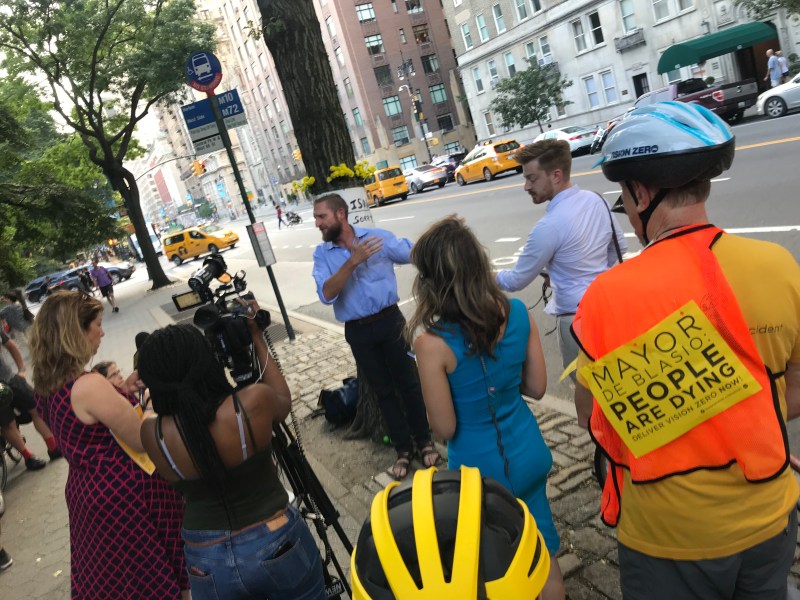Madison Lyden Died On Central Park West Because the City ‘Failed Her’
Activists mourn the death of the Australian tourist one week after a taxi driver and a garbage truck operator teamed up to kill her.

Dozens of cyclists gathered on Central Park West on Friday afternoon to mourn the death of a bike-riding Australian tourist last week and make one plea to city officials: “Not one more!”
Activists with Transportation Alternatives argued that last Friday’s death of Madison Lyden — who was forced to maneuver out of the Central Park West bike path after her route was blocked by a taxi driver only to be fatally run over by the operator of a garbage truck — showed once again why the tourist and recreational Mecca needs to be ringed by a two-way protected lane.
“Madison Jane Lyden did not have to die,” TransAlt Executive Director Paul Steely White told the three dozen mourners. “She didn’t because it was an ‘accident.’ She died because our city failed her. Our city failed to protect her basic safety.”

His group tallied the number of injured cyclists on Central Park West since 2011 — 136, including the one fatality — prompting White to lead a chant of “Not one more!” He also pointed out that the driver of the cab that blocked the bike lane was not charged.
“The city is failing to enforce rules against parking in the bike lane,” White said. “It’s illegal to park in the bike lane! It’s illegal to drop off in the bike lane! But we see it every day. We want NYPD to use a data-driven approach that focuses on infractions that are actually injuring and killing people.”
If the NYPD is unwilling to go after scofflaws, the Department of Transportation must expand street safety redesigns — and not just after deaths like Gelacio Reyes on 43rd Avenue in Queens in 2017 or Joshua Lew and Abigail Blumenstein on Ninth Street in Park Slope in March. Both of those roadways are getting protected bike lanes that could have prevented the deaths.
“Protected bike lanes must be the standard,” White said. “The rule, not the exception.”
White got critical support this week from the neighborhood’s Council Member Helen Rosenthal, who announced her support for a street redesign.
“I want a two-way protected lane not just on Central Park West, but all the way around Central Park,” she told the crowd.

As White and Rosenthal spoke, of course, taxi drivers continued to block the bike path, forcing cyclists into the roadway. And there’s a certain irony to demands for a redesign because the flaws of Central Park West are the same as many, many streets in New York City: a bike lane that offers protection to cyclists in the form of millimeters of white paint that sits inches from buses moving in and out of a bus stop, itself inches from two lanes of uptown traffic, one of which is constantly blocked by turning vehicles that cars swerve around into the bike lane.
The main difference is this bike lane is next to one of the world’s great tourist attractions.
But it is also in a neighborhood that has fought efforts to redesign the street for a predictable, if misguided, reason.
“Some people think parking is more important than human life, that a few parking spaces are more important than safety,” White said. “We want to the mayor to choose human life over parking and remove some spaces.”

Car ownership on the Upper West Side is lower than the city average with fewer than 25 percent of households owning a car — meaning that the vast majority of Upper West Side residents have no need for on-street private car storage in the public right of way.
For all her support for a protected bike lane, Rosenthal was flummoxed when Streetsblog asked her if she would support the removal of on-street car storage in a neighborhood where the majority of residents don’t need it.
Streetsblog: If you remove the parking lane, there would be more room for the majority of users of the public roadways: buses, drivers, pedestrians and cyclists. Where are you on the issue of private car storage in the public right of way?
Rosenthal: You know, I hear what you’re getting at. So don’t think me daft, but my energy is entirely into getting the MTA fixed. The single biggest reason that we have so much congestion and so many cars on the road is because of the MTA not doing its job. … That’s where my focus is. I understand your question and where you’re coming from, but in my mind, this is all caused by a broken MTA.
Streetsblog: But if you remove a lane of parking, it would help congestion…
Rosenthal: I’m looking forward to seeing the street design for the two-way bike lane circling the park, so we’ll see.






